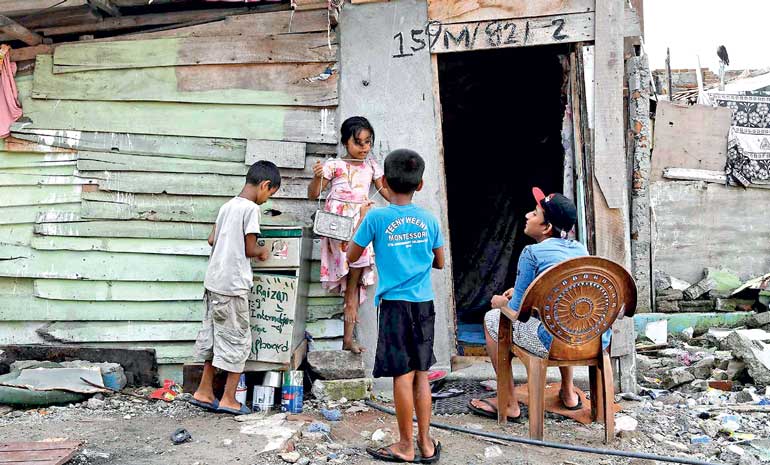Wednesday Dec 31, 2025
Wednesday Dec 31, 2025
Tuesday, 2 November 2021 01:38 - - {{hitsCtrl.values.hits}}

It is not just a moral obligation but a strategic imperative for every country to implement fully, the slogan: no child should be left behind – Pic by Shehan Gunasekara
|
 After being in limbo for many months due to the pandemic, which shuttered all schools in March 2020, primary students started trickling into classes last week. These are indicators of a system gradually limping back to normalcy. Sri Lanka is one of last countries in the world to recommence school education post pandemic. Similarly, it was one of the last to commence teacher-student vaccinations. Thankfully, both are on track now.
After being in limbo for many months due to the pandemic, which shuttered all schools in March 2020, primary students started trickling into classes last week. These are indicators of a system gradually limping back to normalcy. Sri Lanka is one of last countries in the world to recommence school education post pandemic. Similarly, it was one of the last to commence teacher-student vaccinations. Thankfully, both are on track now.
During recent school closures, less than 45% of school students had access to some form of internet-based education. This was usually through PDF notes on WhatsApp, or online classes via Zoom using parents’ feature phones or tabs, or rarely through computers and laptops. But that too came to a grinding halt in July 2021 when teachers launched trade union action. This left students without any form of education and those with funds, at the mercy of private tuition masters.
We still don’t know how many students dropped out of school during this pandemic. Even before 2020, out of about 340,000 students who enter school at Grade one, only about 200,000 applied for the GCE A/L at the end of the school years. Indicating that about 140,000 either drop out of school education, or a small proportion join vocational training courses, or fewer opt for private education.
In 2020, the net enrolment rates in primary education was 98.5% and secondary education 92%, as per the School Census1. More boys drop out after Grade six and 14% of students do not complete eleven years of schooling. In 2015, 34% left the schooling system after the GCE O/L at 14-15 years. Given this data, it’s likely that the pandemic led to a significant number leaving school, never to return.
At a recent webinar organised by the Worldwide Commission to Educate All Kids post pandemic2 it was shown that India had more than a million students ousted from formal schooling, with some girls pushed into early marriage, whereas China kept schools open for a large part of the pandemic, and clearly will have a leg up in post pandemic recovery, economically and socially.
Most developed countries in the East and West planned school reopening well ahead and prepared very early for assessing student learning deficits. They trained teachers for catch-up learning in small groups, relieved students of examination pressure, and didn’t overburden students when they returned to school. Countries with Compulsory Education legislation in place, swiftly ensured implementation, no sooner the pandemic started to abate.
Issues in Sri Lanka
Even as we see a semblance of normalcy returning to our pandemic-battered education system, Sri Lanka has some major issues to deal with.
First of all, authorities at the centre and in the provinces should ensure that no student is left behind when all grades in all schools reopen in a few weeks. Within the free education system, we have an excellent regional education administration system which would enable divisional education directors and zonal directors to work with Grama Niladari divisions at village level to motivate parents to send children to school.
The Compulsory Education Act should be implemented completely in spirit. Families in which children are most likely to drop out of school would be those in lower socio-economic groups where children may join parents’ livelihoods. Such families should be especially visited and parents encouraged to send children to school.
Second, late as it may be, teachers should be guided on how to start teaching-learning in a grade-appropriate manner, so that students who have had zero education these past months won’t feel left out. Allow teachers to innovate during this post pandemic period and not be shackled by the eternal drive towards covering syllabuses.
Emphasis on empathy, and understanding are a must, remembering that over 45% of students did not have any education at all for nearly 20 months. Our teachers are a valuable resource and can become very creative when the situation demands. It’s up to the authorities to motivate, encourage and incentivise them.
Third, teachers themselves have been victims of injustice and ridicule for the past several months. Antagonism, insensitivity and scant respect for this important group of the Sri Lankan Public Service speaks volumes on how the subject of education is ‘prioritised’ in a national agenda.
We spend less than 2% of the GDP on education – perhaps the lowest in South Asia. We pay our teachers the least, from amongst all South Asian countries. The annual teacher salary as a percentage of GDP per capita in Sri Lanka is less than 1.0% as opposed to India (2.3), Bangladesh (2.3), Nepal (2.8), Pakistan (1.9). It’s still not too late to rectify gross salary anomalies and recognise teachers’ invaluable service, and reward them appropriately in the forthcoming Budget.
Fourth, students should be given ample notice and space for preparation for the main three national exams. The examination schedule for 2022 should be clearly and unambiguously published soon, and not changed haphazardly, at whim.
Finally, the Government should understand the gravity of the consequences of the country’s student population being shut out of school for nearly 20 months. This should be dealt with the seriousness it deserves. Sri Lanka should join the chorus of educationists and global leaders who are now championing that schools should never be closed again, except in extreme natural disasters or when a nation is at full war.
It is not just a moral obligation but a strategic imperative for every country to implement fully, the slogan: no child should be left behind.
Footnotes
1 Source: School Census, 2020, Department of Census and Statistics
2 https://www.theglobeandmail.com/opinion/article-canadas-post-pandemic-future-turns-on-excellent-in-education/